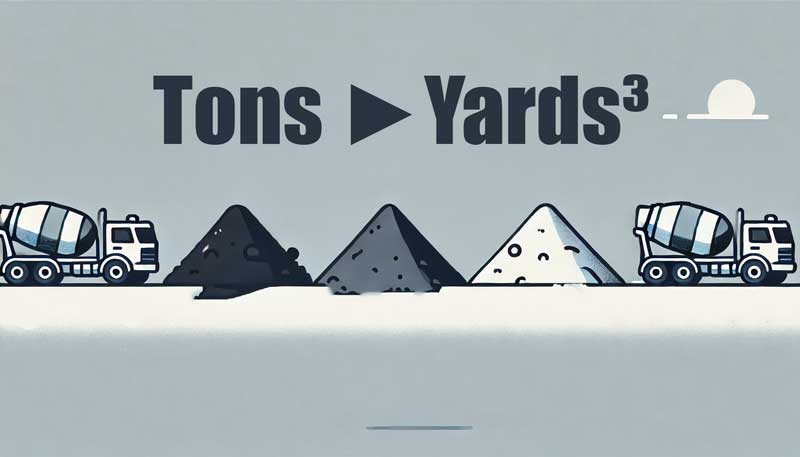This converter allows users to convert between tons and cubic yards for a variety of materials commonly used in construction, landscaping, and similar industries. It calculates the volume (in cubic yards) for a given material weight (in tons) or vice-versa, based on the density of the material. The tool supports predefined materials such as asphalt, concrete, sand, gravel, limestone, topsoil, and mulch, among others. Users can also enter custom density values for any material not listed.
Tons to Cubic Yards Converter
This tool converts between tons and cubic yards automatically for various materials. You can enter values in either field, and the calculation will be done both ways.
Density will update automatically when you pick a material or change the density unit. But you can adjust it as you need.
How does it work?
The converter takes the density of the selected material and either calculates the volume (in cubic yards) based on the weight (in tons) or calculates the weight based on the volume. The tool allows users to:
- Enter either tons or cubic yards to automatically calculate the other value.
- Choose from three density units: tons/yd³, lb/ft³, and kg/m³, with automatic conversions between these units.
- Adjust decimal precision for more accurate results.
Table of Materials Provided in This Converter
Here are the densities used in the logic of this converter in all the measurement units provided for calculations. Also, we precalculated their volumes in cubic yards for one ton of material.
Note: You can customize the density of any material in the converter for precise calculation.
| Materials | t/yd3 | lb/ft3 | kg/m3 | Cubic yards per 1 ton |
| Asphalt (crushed) | 0.61 | 45 | 721 | 1.6393 |
| Asphalt (liquid) | 0.84 | 62.4 | 1000 | 1.1905 |
| Cement (portland) | 1.25 | 94 | 1506 | 0.8 |
| Concrete | 1.76 | 145 | 2320 | 0.5682 |
| Dirt | 1.42 | 95 | 1520 | 0.7042 |
| Gravel (loose, dry) | 1.42 | 95 | 1520 | 0.7042 |
| Gravel (dry, 1/4 to 2 in) | 1.48 | 100 | 1600 | 0.6757 |
| Gravel (wet 1/4 to 2 in) | 1.78 | 120 | 1920 | 0.5618 |
| Gravel (with sand) | 1.65 | 122.22 | 1957.81 | 0.6061 |
| Limestone (crushed) | 2.31 | 171 | 2739 | 0.4329 |
| Limestone (low density) | 1.49 | 110 | 1760 | 0.6711 |
| Limestone (high density) | 2.16 | 160 | 2560 | 0.463 |
| Mulch (bark) | 0.54 | 40 | 641 | 1.8519 |
| Mulch (woodchip) | 0.6 | 45 | 721 | 1.6667 |
| Sand (dry) | 1.48 | 100 | 1600 | 0.6757 |
| Sand (loose) | 1.42 | 95 | 1520 | 0.7042 |
| Sand (wet) | 1.78 | 120 | 1920 | 0.5618 |
| Topsoil (dry) | 1.35 | 100 | 1600 | 0.7407 |
| Topsoil (saturated) | 1.55 | 115 | 1843 | 0.6452 |

Crushed asphalt, concrete, cement in large volumes
History and interesting facts
Cubic yards and tons are commonly used measurement units in industries such as construction, landscaping, and civil engineering. A cubic yard is a volume measurement, often used to determine the amount of material required for filling spaces, such as soil, gravel, or concrete. A ton, in this context, refers to a short ton (2,000 pounds) and is used to measure the weight of materials.
In many projects, it’s crucial to convert between these units because materials are typically bought and sold by weight (tons), while project requirements are measured in volume (cubic yards). This converter simplifies the process by providing accurate, density-based calculations across a range of materials, allowing for precise project planning and material procurement.
© CalcuLife.com








Leave A Comment